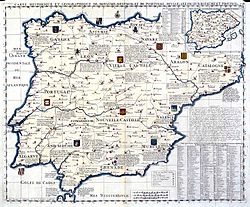Ancient and Medieval
| History of Spain |
|---|
 18th century map of Iberia |
| Timeline |
- 243 BCE - Kart-hadasht founded by Carthaginian Hasdrubal the Fair (approximate date). [1]
- 209 BCE - Battle of Cartagena (209 BC). [2] and renamed Carthago Nova by the victorious general Scipio Africanus
- 100-200 CE - Roman Catholic Diocese of Cartagena established. [3]
- 425 CE - City sacked by the Vandals. [4]
- 1243 - Sacked again by Ferdinand III of Castile. [2]
- 1276 - James I of Aragon in power. [2]
- 1289 - Catholic see relocated from Cartagena to Murcia. [2]